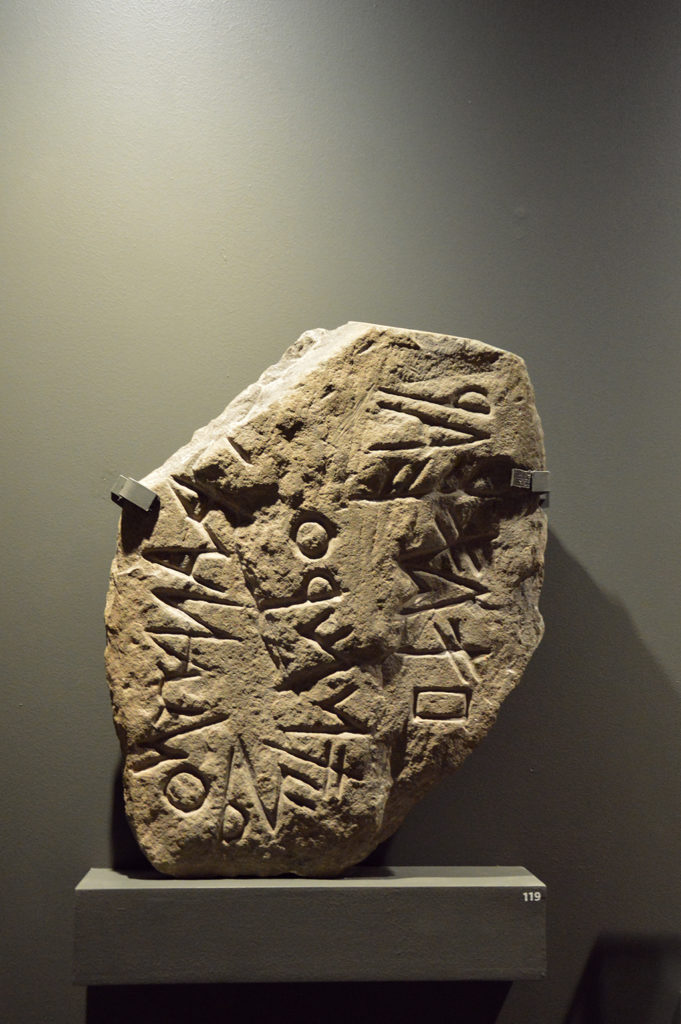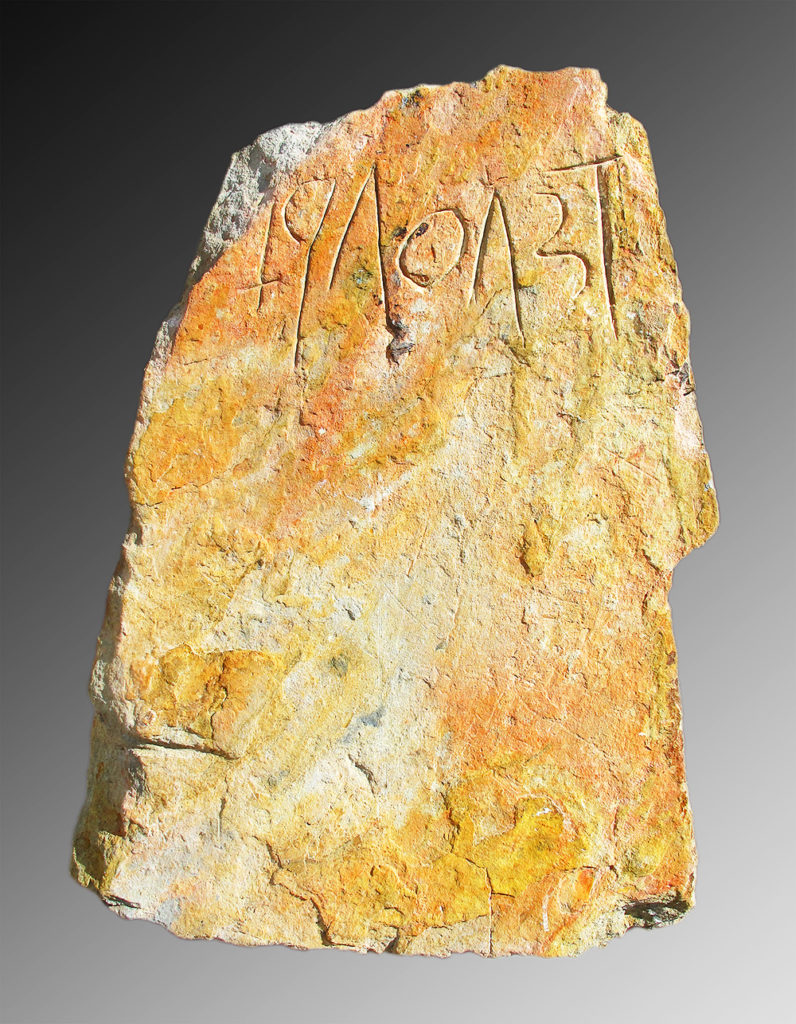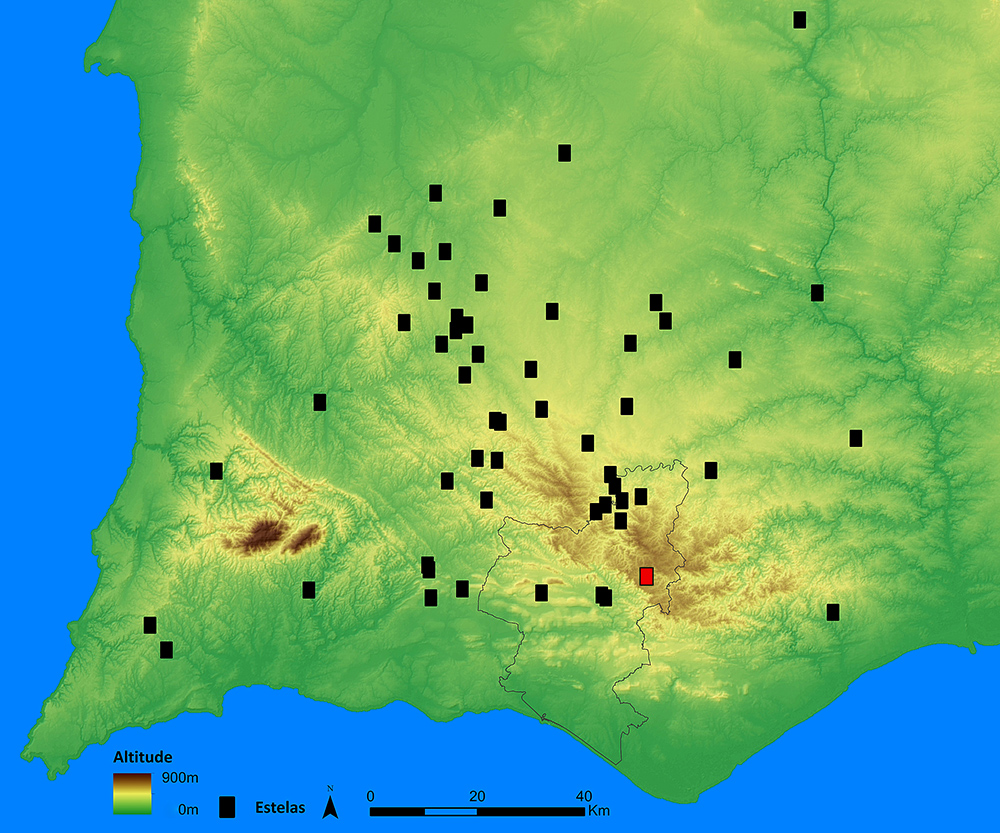A new stele, with seven to eight signs of the mysterious writing of the Southwest, found at the end of spring in the municipality of Loulé, is today unveiled in the Portuguese edition of the magazine «National Geographic» and can now be seen at the Museu de Loulé.
This stele (block of stone that fixed to the ground), with more than 2500 years, ie, from the Iron Age, had been collected about eight years ago by Jorge Narciso, from the Serra do Caldeirão Ethnographic Group, who found it. in Cortelha, as part of the wall of a well built by his father-in-law many years before. The stone had the letters face down.
It started to be used, always with the letters facing downwards, as an ornament by the Ethnographic Group of Serra do Caldeirão, where it symbolized the stone of the washerwoman. And it was last May, during the procession of the Festa da Espiga, in Salir, that the photographer Jorge Graça, with his attentive look, saw her and recognized the symbols of Southwestern writing inscribed on her.
«Jorge Graça, who is a professional photographer with a lot of work done on the heritage of Alte and the mountains, photographed the piece, spoke with Dália Paulo and sent me images. And that was how we confirmed that it was, in fact, a fragment of a new stele», recalled Pedro Barros.
Dália Paulo, director of the Loulé Chamber, told the Sul Informação that the way “this stele was appropriated by the Folklore Group and later discovered is worth telling. For years this stone was part of the float that the group made for the ethnographic procession. This year, Mr. Narcissus didn't make the car, and instead of putting it with the letters facing down, they put it upside down. And it was at the show that Jorge Graça noticed. This stone had already passed in the parade all these years, but no one had yet noticed its archaeological value».
Jorge Narciso, the person in charge also stressed, “I didn't know what it was, but I had realized that the stone was of interest. In such a way that he incorporated it into the ethnographic parade».
According to archaeologist Amílcar Guerra, from Uniarq – Center of Archeology of the Faculty of Arts of the University of Lisbon, «the reading of the text is clear, with all traces well engraved, and reveals some rare signs and others unpublished».
The stele fragment, measuring 48×37 centimeters, has “seven to eight engraved signs”, recognizing the E, R and A. This writing, which is concentrated in the Southwest Peninsular, hence its name, adapted the Phoenician alphabet and then he created his own writing adjusted to the language of the populations that lived here.
Pedro Barros, one of the archaeologists responsible for the “ESTELA Project”, which has led to the discovery, inventory and study of these objects, stresses that the stelae are “one of the greatest treasures of European archeology, with only about a hundred examples and most were found in Portugal (close to 90%)”.
«This writing is a privileged symbol of the historical heritage of the Algarve and Baixo Alentejo, as it is, after all, the oldest written manifestation of the Iberian Peninsula and still has to be deciphered today», he adds.
In the case of this new Estela da Cortelha, in addition to its contribution to the linguistic investigation of the mysterious and still undeciphered writing of the Southwest, its importance has to do with the fact that it was «found in an area where until today no archaeological remains of the Iron Age have been found. , thus revealing the enormous potential that the Serra between the Algarve and Baixo Alentejo has, to investigate this theme».
«This stele also reveals that there is a transition zone and not a hiatus», as it seemed until now, in the Serra do Caldeirão, between the «two known complexes in the municipality of Loulé, one in the Ameixial area, where it was found 10 years ago the last stele, and another in the Benafim/Salir zone», stressed Pedro Barros, speaking to Sul Informação.
«If well crafted from an archaeological point of view, the mountain will reveal many of the secrets it still hides», added the archaeologist who, together with Samuel Melro, has been responsible for the “ESTELA Project".
For now, in the coming months, the pair of archaeologists hope to be able to return to the valley where the well is located, as they may have "a lot of archaeological potential", to try to "identify the archaeological site from which the stele comes", which could be a necropolis. . But Pedro Barros doesn't have too many expectations, since «everything may have already been disturbed», while the area is covered with scrub, which makes the work of archaeological prospection difficult.
After discovering its importance, the Cortelha stele, which was donated by Jorge Narciso, to the Municipal Museum of Loulé, in an «extraordinary example of free and responsible citizenship», can be seen from today, July 27th, until at the end of September, in that museum structure.
“As in this case, there is information that may be in the possession of many people in the land, who do not know the importance of what they have in their hands. So, if anyone has something archaeological that might be of interest, my appeal is to go to the Loulé Museum to see if it's important», concluded Pedro Barros.

The remaining stelae with writing from the southwest of the municipality of Loulé can also be seen in the award-winning archeology exhibition “Loulé: Territories. Memoirs. Identities”, on display until the end of the year at the National Archeology Museum, in Lisbon, as well as at the Sudoeste Writing Museum, the MESA, in Almodôvar, dedicated to the theme.
The Câmara de Loulé emphasizes that «it has been promoting and supporting a series of actions to enhance this Cultural Heritage within the county», such as the initiatives of the Ameixial Walking Festival (Walking Festival Ameixial), which «chose this writing as its identity and differentiating factor”, or the “candidacy for the valorization of the archaeological sites of writing in the Southwest of Ameixial, or even the recent tribute to José Rosa Madeira, who donated an important set of stelae with writing from the Southwest to several Museums”.
In preparation, by the Museum of Loulé, and integrated in the activities of the European Year of Heritage on the theme “Sharing Memories”, is “a tribute to the guardians of Loulé's identity, the singular “Louletians” and worthy donors, without whom the Museum Municipality and local, regional and even national history today would not be the same».
It will be on the 27th of September, as part of the European Heritage Days. "Mr. Jorge Narciso will be one of our special guests that day and one of the people who will be honored," revealed Dália Paulo.




















Comments